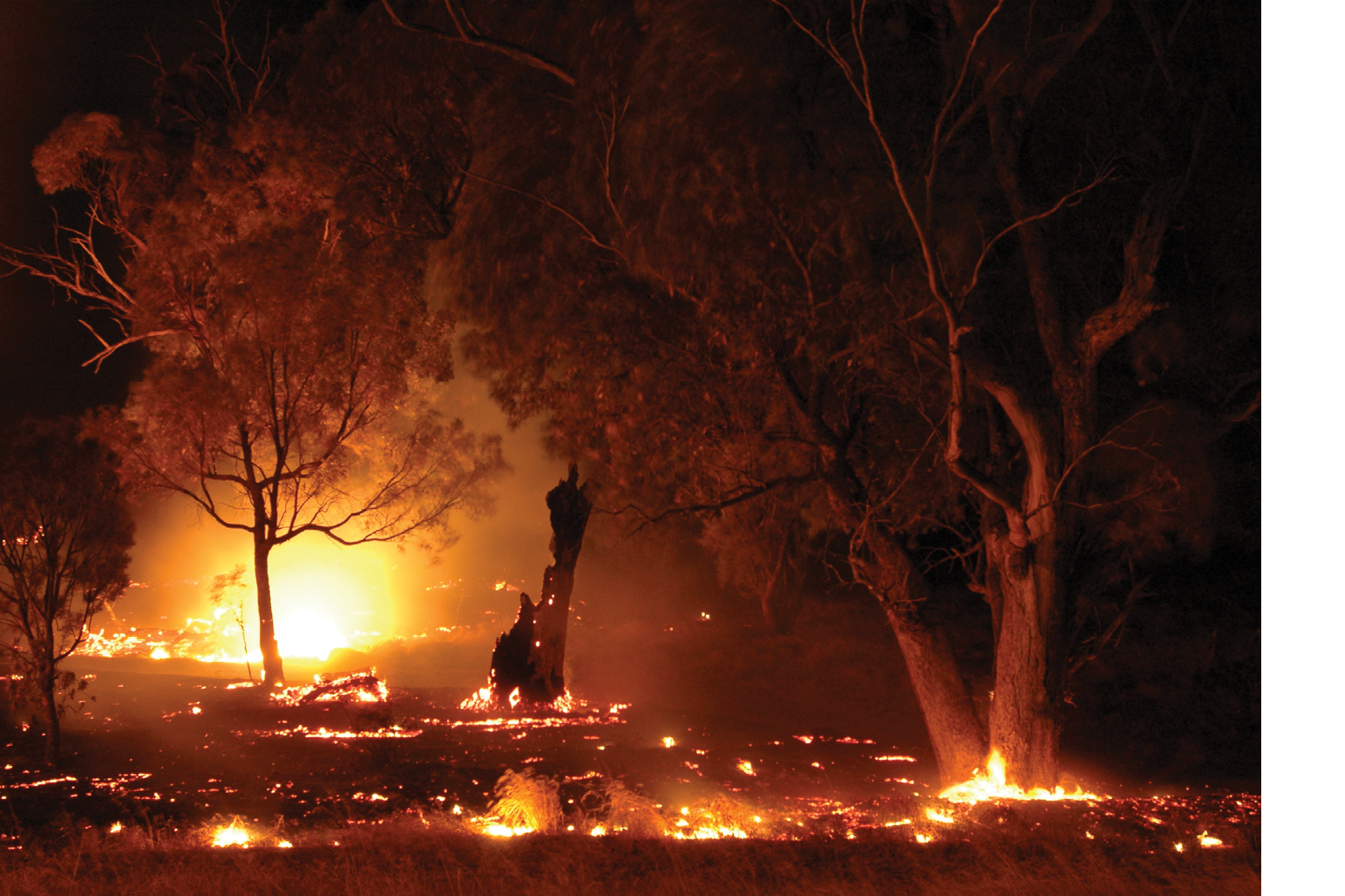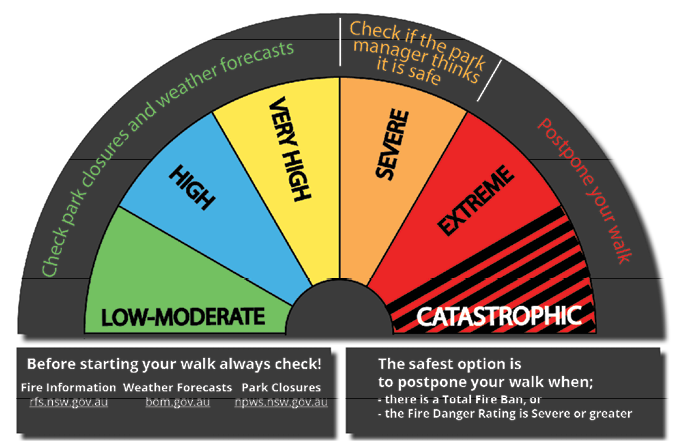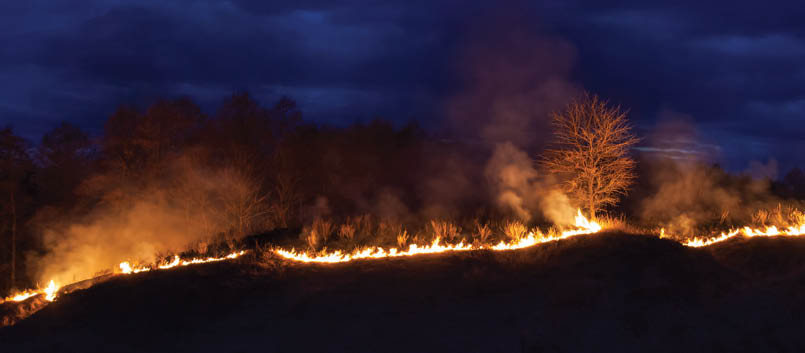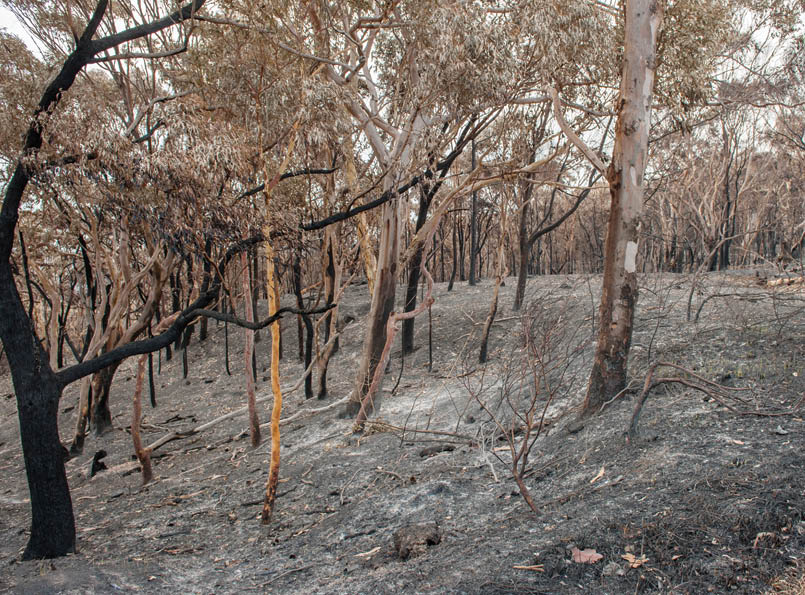

I could not imagine anything more terrifying than having a bushfire bearing down on me on a hot and windy day. On such a day the fire front can throw hot embers many kilometres from the main fire, starting new fires and causing the fire to spread rapidly. The radiant heat from many fires is so intense that even 100 metres away it can cause serious burns to your skin. There is no jumping in a creek or wombat hole to avoid this fire. The only way to ensure your survival is to have planned to be somewhere else. This can happen on a day only halfway up the Fire Danger Rating scale, and, although rare, it can get very ugly out there.

Walking on Fire
Matt McClelland

44 | BWA December 2019


As technology makes bushwalking safer, lighter and easier, climate change is leading to much more hazardous fire conditions for bushwalkers. Although relatively few bushwalkers have been caught up in bushfire emergencies, the bushfire season is becoming longer, and the fires are getting bigger and more fierce. It is something we all need to get our head around.
Changing conditionsWe all know that the climate is changing. We are witnessing mean average temperatures rising. So far the temperature has risen by about 1 °C and we are looking at another degree soon. It does not sound like much, but those few degrees indicate that a huge amount of extra energy has been stored in our atmosphere and oceans. This energy is what powers our weather systems, and with all this extra energy our weather systems are given a massive boost. This is why weather becomes more extreme as the climate warms; we not only get more hot days, but we get more record hot days. We also experience more extreme cold, more heavy rainfall and longer more severe droughts. Australia has been a land of extreme weather for a long time, but buckle up because it is getting more extreme.
About fire ranger ratingsThe Fire Danger Rating (FDR) gives the community a sense of how difficult it will be to control or suppress a bush or grass fire. The FDR is mostly based on the Fire Danger Index (FDI) for forest or grassland (or moorlands in Tasmania). The FDI is a scale from 0-200, with zero being very difficult for a fire to take hold to fires being more aggressive as the numbers rise.
The FDI was developed by the CSIRO in the 1960s. The index considers the dryness of potential fuel (based on rainfall and evaporation) and then forecast or current wind speed, temperature and humidity. Increase the wind speed, temperature, or dryness, or decrease the humidity and the FDI will increase.
During the 2009 Black Saturday fires, the forest FDI was over well over 100 (which was the top of the FDR at the time). After the Black Saturday fires “Catastrophic” (code red in Victoria) was added to the FDR.
The basic mapping for FDRs and FDIs is as follows. There are other factors but this will give you a sense of general relationship.
Category
Fire Danger Index
Forest
Grassland
Catastrophic (Code Red)
100 +
150 +
Extreme
75–99
100–149
Severe
50–74
50–99
Very High
25–49
25–49
High
12–24
12–24
Low–Moderate
0–11
0–11
The FDR is not based on existing fires. It is a general prediction of fire behaviour for existing or new fires. The higher the rating, the more dangerous the conditions are likely to be. At higher ratings, any fire that starts will likely to be fast-moving and difficult to control. No matter what the forecast Fire Danger Rating, if you live in or are travelling to an area that could be affected by a bushfire you need to have a bushfire plan in place so you know what to do if a bushfire starts.
BWA December 2019 | 45
Total fire bansTotal Fire Bans (TOBANs) are determined by the commissioner for bushfire in each state and territory. The decisions are based mostly on the FDR but also emergency service resource demand and other factors. Total fire bans are generally announced mid-afternoon the day before and are in effect for 24 hours from midnight to midnight.
Can I use my fuel stove?Generally speaking, no you can’t use a portable stove outdoors during a Total Fire Ban outdoors. In all states and territories the rules are very clear: you cannot use any solid fuel stoves or campfire outdoors during a Total Fire Ban.
The use of other stoves is a little unclear. Most agencies only speak about solid fuel or gas barbeques, not about bushwalking stoves or liquid fuels such as metho fuel stoves. Their intention is clear, a bushwalking stove is a barbeque. Always assume the safest option and don’t use a stove unless you are sure it is allowed and safe in your context.
The rules vary between states and territories. The minimum rules are set by the agency responsible for bushfire management in
each state, not the land manager. The land manager can set extra rules on top of this, so check the rules for the place you are visiting.
In Western Australia, New South Wales, Victoria, and Queensland you can't use your bushwalking stove during a Total Fire Ban.
Australian Capital Territory. Generally, you can’t use portable stoves during a Total Fire Ban. They do say you can use a barbeque for cooking if the area around is clear of any flammable material for a distance of three metres, is under the control of an adult, and there’s a continuous supply of water. However many parks and reserves will also be closed during a Total Fire Ban.
South Australia. Generally, you can't use a gas stove, except on a coastal foreshore. You still need the area clear of any flammable material for a distance of four metres, and be under the control of an adult with an appropriate fire extinguisher.
Tasmania is the only state with a general exception for bushwalkers. In Tasmania, only LPG (butane or propane) cookers or stoves can be used, providing that they are clear of any flammable material for a distance of one metre.

BWA December 2019 | 47
Total Fire Bans are not just about fires as we normally think of them. In Western Australia, for example, it is illegal to drive off a road into the bush or paddock due to the risk of the car's heat starting a fire in the grass or scrub. So be aware of your responsibilities with anything hot during total fire bans.
On longer walks, you may not be able to get the latest forecast and Total Fire Ban information. You can carry communications gear, or try using your mobile phone or AM radio to check. If you can’t know exactly, you will need to make a judgement based on the conditions, erring on the side of caution. During the bushfire danger period be prepared with non-cook meals.
Go or No Go decisionDeciding to cancel, change or postpone a walk can be very difficult. During elevated fire danger periods the park service may close the parks making your decision for you. The general advice on days of Extreme or Catastrophic (code red) Fire Danger ratings is to stay out of bushfire prone land altogether, cancel you bushwalks. On days of Severe Fire Danger Ratings, or when there is a Total Fire Ban, start with the assumption you should cancel and then look to see if your specific plans are safe considering the specific conditions.
Always have a Bushfire Survival Plan for your walks.
Especially on multi-day trips, leave your walk plans with the local police and the land manager's office. Also, tell a responsible
person at home your plan and they can contact the fire service if they have concerns for your welfare due to bushfire (or other) conditions whilst your walking. You should not rely on such rescue, but proactive rescues have happened in the past.
What to do if caught in a fire?It is always best to avoid getting caught by changing you walk plans when there is an elevated risk of fire, but sometimes fires happen. NSW RFS have a Bushwalkers bushfire safety brochure. These key points by no means guarantee survival or an injury-free outcome, but they may help reduce the severity of the outcome.
Don’t panic, don’t try to outrun the fire.
Call Triple Zero 000 (else trigger PLB assuming there is a grave and imminent danger)
If you see smoke, turn back or find a safer alternate route.
You will not be able to outrun a fire. Find a cleared area. Look for rocks, hollows, embankments, streams or roads to protect you.
Head to lower ground, avoid going uphill and do not shelter in water tanks.
Keep low and cover your skin.
Drink water and cover your mouth with a damp cloth.
Move to burnt ground when the fire has passed.
As a last resort, choose a place with a fairly clear ground and flames less than one metre deep and high. Take a deep breath, cover your face and run through the flames to already burnt ground.

48 | BWA December 2019
Finding your FDR ForecastsIf you are in doubt play it safe: there are another 51 weekends in the year. Equally, don’t let this scare you off - pick the days and have alternative activities planned during
fire seasons. By their nature, wild places present risks, so take them seriously but still enjoy them at the right times. I often have a backup trip plan, so if the conditions are not safe then I have an easy alternative option.

State
National Park
Fire Agency
New South Wales
South Australia
Victoria
Queensland
Tasmania
Western Australia
Bureau of meteorology
BWA December 2019 | 49